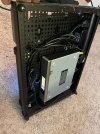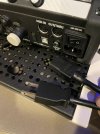bleujazz3
Fractal Fanatic
I've been adjusting this board, and finally have it set up in a semi-permanent configuration. I think.
It's built on a Temple Audio Duo 24. Their 4X Mod is on the right front panel.
It's configured with port #1 going to the FM3 input via a short piece of Bill L's pedal board cable and two of the right-angle plugs. The plugs fit through the large holes on the board. Port #2 and #3 are the volume pedal and wah respectively, both are FAS EV-2 and are configured to be disabled when toe down. The connecting TRS cables are some generic ones from Amazon. All cables are locked down with cable-ties.
The XLR between the FC-6 and FM3 is a '10" Low-Profile XLR-3 Adjustable Angle cable' from Redding Audio.
The Out 1 connectors route under the board to the Temple Audio XLR mod on the trailing left panel. The power is on the left front micro panel and is Temple Audio's IEC mod. I cut the power cable, threaded it through the board, then soldered it back together with extra heat-shrink tubing. Wire ties keep it immobile so I'm not worried about it wearing from vibration, shorting out, and spouting flames.
Originally I used long nylon wire ties, because I wanted to be able to remove the FM3 and FC6 easily, but the ties would slip off when I carried the board in its bag. After thinking about it a while I decided to try using 3M Dual Lock (SJ3560) between Temple Audio's large pedal plates and the units. I cut the Dual Lock into 6x3" strips, then stuck three to the plate's adhesive pad so they were adhesive to adhesive, then pressed three of the strips crossways, then positioned them on the board and placed the units above them to figure out their final locations where the pads would fit just inside the feet on the unit and it sat level on the board. When I was happy I lifted the unit off, then screwed the plates down, peeled off the backing for the top layers of Dual Lock and carefully put the unit back down and pressed it against the adhesive. After letting it sit for a couple minutes I unscrewed the plates, lifted the unit off, turned it over and pressed the plate firmly against the bottom to make sure it had a good grip, then reattached it to the board and screwed the plates back down.
There are multiple types of Dual Lock, and you can mix and match them, depending on what pull strength you want. The SJ3560 version has wavy lines across it, and is clear. Their product page talks about the combinations they recommend, but be warned because their top level is REALLY hard to take apart. I have to use a long flat-head screwdriver to pry apart the stuff I used.
I was concerned the plate might be pulled away from the bottom of the FM3 or FC-6 but the two layers of Dual Lock are the right thickness to fill the gap. I can lift the entire board by the attached FM3 or FC6, there's absolutely no wiggle, and I can easily remove them by undoing the thumbscrews.
I carry it all in the Duo 24 travel bag for local outings.
View attachment 86544
The only thing I'd like to change is to use a locking TS jack, but I tried two different ones and they both added a LOT of noise. I might get one that isn't a straight through design and solder directly to the terminals, but shielding that will be an interesting exercise.
Greg,
Your work looks neat and tidy. Good housekeeping seal of approval here.
Most of the Temple boards I've personally viewed here are outstanding quality. My feelings that something well-constructed should last a long time. For that reason, my weighing of build or no-build are now inclined towards build. Only thing I can't foresee doing for my build is adding a supplemental ¼" port array for my EV-1s. The EV-1s in my case would reside on a Duo 34, connected by 3' TRS thru/under/thru to my FC12, same board.
"Practical use" would add XLR F/M ports for FASlink and XLR MM speaker outs on the Duo 34. My companion Duo 17 FM3 board would add XLR F/M for FASlink and IEC power module.
For gigging use, the XLR MM ports would be sends to FOH. The FM3 Output 2 would be a HeadRush FRFR108 floor monitor send, or not, depending on the venue.
I'm guessing that the XLR F/M will work if trying to connect the FM3 output 2 to the XLR F/M port. (I think I'd need a short length of TRS>TRS cable for this. Trying to comprehend the birds and bees aspect of M>F and F>M XLR/TRS connections/cabling to floor monitor. Plz chime in if anyone reading this happens to know. IIRC, FASlink would require a female port output to male port input on the FC12. Output 2 > male port output connects to female speaker port input. Yeah, I think that's it.)
Separate safe bet would be to bring a FRFR108 in case the venue didn't/couldn't route to floor monitor.
Thanks again for showing us your current rig. Each person's input is valuable.
Last edited:



